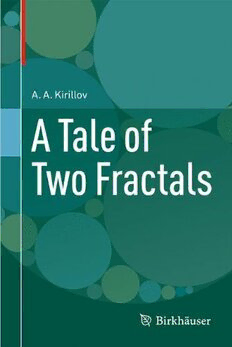
A Tale of Two Fractals PDF
Preview A Tale of Two Fractals
A.A. Kirillov A Tale of Two Fractals A.A. Kirillov A Tale of Two Fractals A.A.Kirillov DepartmentofMathematics UniversityofPennsylvania Philadelphia,PA,USA ISBN978-0-8176-8381-8 ISBN978-0-8176-8382-5(eBook) DOI10.1007/978-0-8176-8382-5 SpringerNewYorkHeidelbergDordrechtLondon LibraryofCongressControlNumber:2013933043 MathematicsSubjectClassification(2010):00A09,26A30,28A80,57S ©SpringerScience+BusinessMediaNewYork2013 Thisworkissubjecttocopyright.AllrightsarereservedbythePublisher,whetherthewholeorpartof thematerialisconcerned,specificallytherightsoftranslation,reprinting,reuseofillustrations,recitation, broadcasting,reproductiononmicrofilmsorinanyotherphysicalway,andtransmissionorinformation storageandretrieval,electronicadaptation,computersoftware,orbysimilarordissimilarmethodology nowknownorhereafterdeveloped.Exemptedfromthislegalreservationarebriefexcerptsinconnection with reviews or scholarly analysis or material supplied specifically for the purpose of being entered and executed on a computer system, for exclusive use by the purchaser of the work. Duplication of this publication or parts thereof is permitted only under the provisions of the Copyright Law of the Publisher’slocation,initscurrentversion,andpermissionforusemustalwaysbeobtainedfromSpringer. PermissionsforusemaybeobtainedthroughRightsLinkattheCopyrightClearanceCenter.Violations areliabletoprosecutionundertherespectiveCopyrightLaw. Theuseofgeneraldescriptivenames,registerednames,trademarks,servicemarks,etc.inthispublication doesnotimply,evenintheabsenceofaspecificstatement,thatsuchnamesareexemptfromtherelevant protectivelawsandregulationsandthereforefreeforgeneraluse. While the advice and information in this book are believed to be true and accurate at the date of publication,neithertheauthorsnortheeditorsnorthepublishercanacceptanylegalresponsibilityfor anyerrorsoromissionsthatmaybemade.Thepublishermakesnowarranty,expressorimplied,with respecttothematerialcontainedherein. Printedonacid-freepaper Springer ispartofSpringerScience+BusinessMedia(www.birkhauser-science.com) To Benand Lisa Preface Thisbookisdevotedtothephenomenonoffractalsets,orsimplyfractals.Fractals havebeenknownforaboutmorethanacenturyandhavebeenobservedindifferent branchesofscience.But itisonlyrecently(approximatelyin thelast thirtyyears) thattheyhavebecomeasubjectofmathematicalstudy. ThepioneerofthetheoryoffractalswasBenoitMandelbrot.HisbookFractals: Form,ChanceandDimensionfirstappearedin1977,andasecond,enlarged,edition waspublishedin1982.Sincethattime,seriousarticles,surveys,popularpapers,and booksaboutfractalshaveappearedbythedozen(ifnotbyhundreds).Also,in1993, the specialized journalFractalswas publishedby World Scientific. So, why write onemorebook? First, it turns out that in spite of the vast literature, many people, including graduate students and even professional mathematicians, have only a vague idea aboutfractals. Second, in many popular books, the reader finds a large number of colorful pictures and amazing examples but no accurate definitions and rigorous results. In contrast, the articles written by professionals are, as a rule, too difficult for beginners and often discuss very special questions, assuming that the motivation andallconnectionsarealreadyknowntothereader. Last, and perhaps the most importantreason, is my belief that the endeavor of independentstudyofthegeometry,analysis,andarithmeticoffractalsisoneofthe bestwaysforayoungmathematiciantoacquireanactiveandstableknowledgeof thebasicmathematicaltools. Thissubjectalsoseemstometobeanexcellentopportunitytotestyourability toproducecreativeworkinmathematics.1Imeanherenotonlysolvingwell-posed problems,butrecognizinghiddenpatternsandformulatingnew,fruitfulproblems. MyinterestinfractalsoriginatesfromthelecturecourseIgaveattheUniversity of Pennsylvania in 1995 at the request of our undergraduate students. I repeated the course in 1999, 2003, and 2005. In 2004 and in 2007, I had the opportunity 1AccordingtoYu.I.Manin,tocreateinmathematicsistocalculatewithexcitement. vii viii Preface to present the material in several lectures at the summer school in Dubna, near Moscow, organizedfor high school seniors and first-year university students who werewinnersoftheRussianMathematicalOlympiad.Bothtimes,Iwaspleasantly surprisedbytheactivityofthe audienceandbytheirquicknessincomprehending allofthenecessaryinformation. Inthisbook,wedeliberatelyrestrictourselvestoonlytwoexamplesoffractals: theSierpin´skiandApolloniangaskets.I describeandrigorouslyformulateseveral problemsthatcomefromthestudyofthesefractals.Mostofthemcanbeformulated andsolvedindependently,butonlythewholecollectiongivesanunderstandingof theworldoffractals. Some of these problemsare more or less simple exercises, some are relatively new results, and a few are unsolvedproblemsof unknowndifficulty.The solution (and even formulation and understanding) of all the problems requires some preliminarybackground,whichcontains,inparticular,thefollowing: • Elementsofanalysis:functionsofonevariable,differentialandintegralcalculus, series. • Elements of linear algebra: real and complex vector spaces, dimension, linear operators,quadraticforms,eigenvaluesandeigenvectors.Coordinatesandinner products. • Elements of geometry: lines, planes, circles, disks, and spheres in R3. Basic trigonometricformulas.Elementsofsphericalandhyperbolicgeometry. • Elementsofarithmetic:primes,relativelyprimenumbers,gcd(greatestcommon divisor),rationalnumbers,algebraicnumbers. • Elements of group theory: subgroups, homogeneous spaces, cosets, matrix groups. All of this is normally contained in the first two or three years of a university mathematicscurriculum. I consider the diversity of the necessary tools and their interconnection a great advantage of this subject, because it is a characteristic feature of modern mathematics. Letmeofferseveralwordsaboutthestyleofexposition.Itriedtoavoidtwomain dangers:beingdullbyexplainingtoomanydetailsinthemostelementaryformand beingincomprehensiblebyusingveryeffectivebutsometimestooabstractmodern techniques.Itistothereadertojudgethesuccessofthisendeavor. I also tried to communicate an informal knowledge of mathematical tools that distinguish(almostall)professionalsfrommostbeginners.Sometimes,onephrase explainsmorethanalongarticle.2 So,fromtimetotime,I intentionallyusesome “high-altitude”notions, explainingeach time in the simplest possible words what theymeaninthesimplestsituations. 2In my experience, this happened when I tried to understand induced representations, spectral sequences,intersectionhomology,etc. Preface ix Someadditionalinformationisincludedinthetextintheformofsectionswith theheading“Info.” I also use “Remarks” as another form of additional information. The end of a remarkisindicatedbythesign~. Theendofaproof(ortheabsenceofproof)ismarkedbythesignut. Acknowledgements The author deeply thanks the Erwin Schroo¨dinger International Institute for MathematicalPhysics (ESI), where thiswork wasbegun; theMaxPlanck InstituteinBonn (MPI); and theInstitutedes HautesEtudesScientifique (IHES), where itwas completed. Ialso thanktherefereesforhelpfulremarks.
